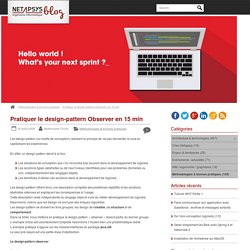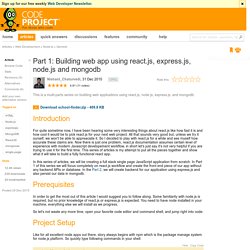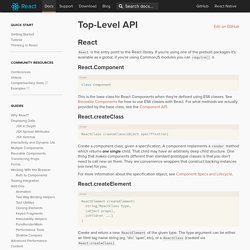

Introduction to Reactive Programming - Course by @andrestaltz. The introduction to Reactive Programming you've been missing. The introduction to Reactive Programming you've been missing (by @andrestaltz) This tutorial as a series of videos If you prefer to watch video tutorials with live-coding, then check out this series I recorded with the same contents as in this article: Egghead.io - Introduction to Reactive Programming.

So you're curious in learning this new thing called Reactive Programming, particularly its variant comprising of Rx, Bacon.js, RAC, and others. Learning it is hard, even harder by the lack of good material. Rx.Observable.prototype.flatMapLatest(selector, [thisArg]) Projects each element of an observable sequence into a new sequence of observable sequences by incorporating the element's index and then transforms an observable sequence of observable sequences into an observable sequence producing values only from the most recent observable sequence. Holy cow. I've read two books, one just painted the big picture, while the other dived into how to use the Reactive library. Request and response. GitHub - reactjs/redux: Predictable state container for JavaScript apps. Observables › Cycle.js. The name “Observable” immediately indicates a relation to the Observer pattern.

This pattern is key in many flavors of the Model-View-Controller architectural pattern for user interfaces. For instance, typically the View observes changes in the Model. In the Observer pattern, this means the Model would be the “Subject” being observed. However, an Observable is not exactly the same concept as a traditional Subject from the Observer pattern, because Observables share features with Iterables from the Iterator pattern as well. Observables are lazy event streams which can emit zero or more events, and may or may not finish. Application Architecture for Building User Interfaces. Flux is the application architecture that Facebook uses for building client-side web applications.

It complements React's composable view components by utilizing a unidirectional data flow. It's more of a pattern rather than a formal framework, and you can start using Flux immediately without a lot of new code. Flux applications have three major parts: the dispatcher, the stores, and the views (React components). These should not be confused with Model-View-Controller. Controllers do exist in a Flux application, but they are controller-views — views often found at the top of the hierarchy that retrieve data from the stores and pass this data down to their children.
Pratiquer le design-pattern Observer en 15 min. Les design-pattern (ou motifs de conception) réalisent le principe de ne pas réinventer la roue en capitalisant les expériences.

En effet, un design-pattern décrit à la fois : Les situations de conception que l’on rencontre trop souvent dans le développement de logicielsLes solutions types (abstraites ou de haut niveau) identifiées pour ces problèmes (formelles ou non, indépendamment des langages objets)Les bénéfices d’utiliser ces solutions dans le développement de logiciels. GitHub - Reactive-Extensions/RxJS: The Reactive Extensions for JavaScript. React.createClass versus extends React.Component @toddmotto. Two ways to do the same thing.

Almost. React traditionally provided the React.createClass method to create component classes, and released a small syntax sugar update to allow for better use with ES6 modules by extends React.Component, which extends the Component class instead of calling createClass. These differences are subtle in places, but have quite a few interesting differences worth exploring, which will allow you to make the best decision for which is best for you. Syntax differences First, let’s explore the syntax differences by looking at two code examples and annotating them.
React.createClass Here we have a const with a React class assigned, with the important render function following on to complete a typical base component definition. React Router: a comprehensive introduction. When you need to route between different parts of your React application, you'll probably need a router.

Part 1: Building web app using react.js, express.js, node.js and mongodb. Download school-finder.zip - 409.8 KB Introduction For quite sometime now, I have been hearing some very interesting things about react.js like how fast it is and how cool it would be to pick react.js for your next web project.

All that sounds very good but, unless we try it ourself, we won't be able to appreaciate it. So I decided to play with react.js for a while and see myself how accurate these claims are. Now there is just one problem, react.js documentation assumes certain level of experience with modern Javascript developement workflow, in short let's just say it's not very helpful if you are trying to use it for the first time. In this series of articles, we will be creating a full stack single page JavaScript application from scratch.
Prerequisites In order to get the most out of this article I would suggest you to follow along. So let's not waste any more time, open your favorite code editor and command shell, and jump right into code: Project Setup Hide Copy Code <! Top-Level API. React #
